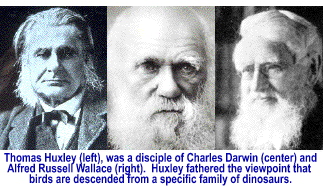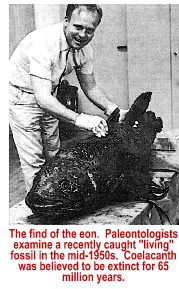
News
Behind the Headlines
Two-Cents Worth
Video of the Week
News Blurbs
Articles
Testimony
Bible Questions
Internet
Articles (2012)
Internet Articles (2011)
Internet Articles (2010)
Internet Articles
(2009)
Internet Articles (2008)
Internet Articles (2007)
Internet Articles (2006)
Internet Articles (2005)
Internet Articles (2004)
Internet Articles (2003)
Internet Articles (2002)
Internet Articles (2001)

Paleontologists torn over question of feathered dinosaurs
British paleontologist Thomas
Huxley started the debate in 1868 when he suggested that feathered
birds were descendants of dinosaurs. Huxley, a student of Charles
Darwin, based his opinion on what he construed to be similar body
structures, ankle joints and the backward phalanx (4th toe) of the Archaeopteryx—a
150 million year-old creature that paleontologists consider to be oldest,
most primitive bird. Others, like Matthew T. Carrano, the curator
of the Dinosauria at the Smithsonian's National Museum of Natural History
believes Archaeopteryx is a "transitional" creature—neither
bird nor reptile—because it combines bird and maniraptoran theropod
features.  "This
is a perfect example where we have an intermediary between one group and
another," Carrano observed. "[Archaeopteryx is]
on its way to being a modern bird, but it's not there." And,
it will never get there. Why?
"This
is a perfect example where we have an intermediary between one group and
another," Carrano observed. "[Archaeopteryx is]
on its way to being a modern bird, but it's not there." And,
it will never get there. Why?
Because there are no transitional
links. It's the age-old question of which came first—the chicken
or the egg? Of course, the chicken came first.  How
do I know that? Because God said it. "And God created great whales,
and every living creature that moveth, which the waters brought forth
abundantly, after their kind, and every winged fowl after its kind."
[Gen. 1:21; KJV] "And God said, Let the earth bring forth the living
creatures after its kind, cattle, and creeping thing, and beast of the
earth after its kind: and so it was. And God made the beast of the earth
after its kind, and cattle after their kind, and everything that creepeth
upon the earth after its kind:and God saw that it was good."
[Gen. 1:34-25; KJV] The humanist would have us believe that something
other than a chicken laid two eggs containing chickens—one male and
one female; and that one-in-a-quad-trillion dual accident of nature sired
what we know today as the chicken.
How
do I know that? Because God said it. "And God created great whales,
and every living creature that moveth, which the waters brought forth
abundantly, after their kind, and every winged fowl after its kind."
[Gen. 1:21; KJV] "And God said, Let the earth bring forth the living
creatures after its kind, cattle, and creeping thing, and beast of the
earth after its kind: and so it was. And God made the beast of the earth
after its kind, and cattle after their kind, and everything that creepeth
upon the earth after its kind:and God saw that it was good."
[Gen. 1:34-25; KJV] The humanist would have us believe that something
other than a chicken laid two eggs containing chickens—one male and
one female; and that one-in-a-quad-trillion dual accident of nature sired
what we know today as the chicken.
Let me say, before I get too far into this for the humanists—I will prove my views to the satisfaction of most of those who read this. Except, perhaps, the diehard secularist who won't believe Hell exists until its fires are toasting their tootsies. What was God saying in Gen. 1:21-25? Quite simply, this: long before man created the term "paleontology," God affirmed that nothing evolved from one species to another. God created each species after its own kind. Life did not slowly develop through an evolutionary spiral, with higher orders evolving from lower orders. Nor is there an evolutionary eraser called natural selection that corrects nature's mistakes and then wipes any trace of those errors from existence. Over 8.5 billion fossils have been found and cataloged. Yet, in all of those fossils not a single transitionary fossil of any type has ever been found.
 With
the ongoing scholastic debate about evolution vs secular creationism,
it is important to acknowledge that there is absolutely no scientific
evidence to support the theory of evolution. None. Zip. Zat. Nadda. Not
one iota. The views held by all evolutionists today are a composite of
the views of two men—Charles Robert Darwin and Alfred Russell
Wallace. Darwin and Wallace were friends, and both were
students of Thomas Robert Malthus who authored the Essay on
the Principles of Population and Sir Charles Lyell who wrote
the Essay on Geology. The combined views of Lyell and Malthus
influenced both Wallace and Darwin to conclude that all
life spiraled upward from a common ancestor, with life transmutating to
fit its selective environment.
With
the ongoing scholastic debate about evolution vs secular creationism,
it is important to acknowledge that there is absolutely no scientific
evidence to support the theory of evolution. None. Zip. Zat. Nadda. Not
one iota. The views held by all evolutionists today are a composite of
the views of two men—Charles Robert Darwin and Alfred Russell
Wallace. Darwin and Wallace were friends, and both were
students of Thomas Robert Malthus who authored the Essay on
the Principles of Population and Sir Charles Lyell who wrote
the Essay on Geology. The combined views of Lyell and Malthus
influenced both Wallace and Darwin to conclude that all
life spiraled upward from a common ancestor, with life transmutating to
fit its selective environment.
The theory of evolution presupposes that all living matter arose from some less sophisticated lifeform completely by chance and, at some point, animate life life was miraculously created from an inanimate source. For the theory of accidental evolution to work, science must be able to substantiate that certain prerequisite conditions existed at the moment of molecular conception in our primeval world—a world without oxygen. Scientists have agreed that for any of the lifeforms that live on Earth to be created, the atmosphere had to consist of ammonia, hydrogen, water, methane and carbon dioxide. This is important because, in laboratory experiments, the synthesis of complex molecules have been artificially achieved—but only in an environment devoid of oxygen.
Do you see a problem here?
The theory that supposes an accidental creation of life is not based on empirical evidence since science has no idea to what degree these chemical compounds existed on our primeval planet. Biochemists believe the necessary chemicals: CH4, H2, N2 and H20 which are abundant throughout the solar system had to be present on Earth during its primeval, lifeless phase. Furthermore, since oxygen is biologically manufactured as a byproduct of plantlife, oxygen is an element that could not have existed in amounts greater than 1%. Because the theory of accidental creation requires an oxygen-free environment, life could not survive once it was created. All known lifeforms on Earth require an oxygen-rich atmosphere to live and propagate. Since all living organisms on earth require oxygen, no organism created in an oxygen-free environment could survive long enough for the primitive plants to consume enough carbon dioxide to generate enough oxygen to keep them alive.
But for a moment, let's assume that is not the case. Let's instead assume Darwin was correct, and that life advanced up the evolutionary ladder through a progression of increasingly complex mutations. Could the mutations Darwin imagined survive once they mutated? What are the odds that the astronomical number of necessarily sequential mutations needed to advance a species up just one rung of the evolutionary ladder would occur in precisely the order needed? And, if such a chain of events did happen, where is the fossil evidence to support the theory that it did happen?
In Science World (Feb. 4, 1983) Dr. Betty Farber, an entomologist for the American Museum of National History, observed that fossilized cockroaches from the Carboniferous Age appear pretty much the same as those found throughout the world today. Anthropologists studying the fossil records from the middle Devonian through the Carboniferous Age have found that other than size, insects have remained virtually unchanged for 275 million years.
The single greatest fallacy with evolution as a valid theory is that it begins with a conclusion and not a premise. The laws governing the establishment of scientific proof have never been successfully applied to the theory of evolution because evolution requires a much greater leap of faith than creationism. The idea that nature could, and would, selectively isolate specific plants and animals and set them on an evolutionary spiral to advance the nonsensical notion life suggests that nature has both an intelligence and a master plan.
The views of the humanists are so narrowly focused on the impossible that they eagerly grasp any evolutionary straw that appears, on the surface, to support their opinion—without testing it against logic to determine whether or not it's likely to be true. The evolution narrative is based entirely on assumption and is not supported by any existing fossil evidence. How do I know this?
Because there is no fossil evidence that evolution exists. None. Zip. Zat. Nadda. Not one iota. Paleontologists have diligently searched the fossil records in vain for any evidence that links invertebrates to the vertebrates, fish to amphibians, amphibians to reptiles, reptiles to mammals and, ultimately, mammals to humans. Furthermore, since the transitions up each evolutionary spire, from cold-blooded to warm-blooded animals and from animals to men, would require thousands of transitional forms, there should thousands—if not millions—of transitional fossils to evidence those evolutionary leaps. Yet, none exist. Not one. Zip. Zat. Nadda. Not a bone or toenail.
 Because
evidence of evolution simply does not exist, the evolutionist has been
forced to construct imaginary phylogenetic models to support links between
lifeforms. The major problem with the modeling is that it infers not only
that minor variations necessarily occur within particular classes that
result in the spontaneous creation of other species within particular
classifications—such as a dog from a cat or an amphibian from a fish.
Because
evidence of evolution simply does not exist, the evolutionist has been
forced to construct imaginary phylogenetic models to support links between
lifeforms. The major problem with the modeling is that it infers not only
that minor variations necessarily occur within particular classes that
result in the spontaneous creation of other species within particular
classifications—such as a dog from a cat or an amphibian from a fish.
 In
the evolutionary chain, paleontologists offered coelacanth—a
Devonian crossopterygian (lobe-finned fish) as the transitional
link between fish and tetrapods. Coelacanth was believed to have
become extinct during the Cretoceous Period—some 65 million years
ago. In 1938 a living coelacanth was netted off the coast of southeast
Africa. Since that time, several have been caught in the waters between
Africa and Madagascar. Coelacanth was an embarrassment to evolutionists
who claimed it had become an air breathing amphibian whose fins became
primitive legs. However, no anatomical differences exist from the 65 million
year old fossils to the living coelacanths.
In
the evolutionary chain, paleontologists offered coelacanth—a
Devonian crossopterygian (lobe-finned fish) as the transitional
link between fish and tetrapods. Coelacanth was believed to have
become extinct during the Cretoceous Period—some 65 million years
ago. In 1938 a living coelacanth was netted off the coast of southeast
Africa. Since that time, several have been caught in the waters between
Africa and Madagascar. Coelacanth was an embarrassment to evolutionists
who claimed it had become an air breathing amphibian whose fins became
primitive legs. However, no anatomical differences exist from the 65 million
year old fossils to the living coelacanths.
Scott Harman was partially right. Archaepteryx is not the link between birds and reptiles. No anatomically different fossils for Archaeopteryx have ever been discovered—and there never will be one. It is what it has been since God created it. The same goes for the so-called "feathered" theropod dinosaurs like Protarchaeopteryx and Caudipteryx—found in China in 1997-98. Although the paleontologists disagree on how dinosaurs evolved into higher lifeforms, they still agree that such transformations did occur. Hartman noted that, "We are trying to narrow down what groups of dinosaurs is closest to birds. They may be the direct descendants of all these groups, but we haven't proven that. It may be there is one that is the ancestor of all three." Perhaps, better stated, there is one Creator who breathed life into all of them.
As the world contemplates the question of whether birds descended from dinosaurs, and mulls the latest revelation that a primitive tyrannosaurus has been discovered in China that indicates that T-rex lived on Earth over twice as long as previously believed someone should be asking why this trivia is filling America's newspapers at this time. These recent discoveries and discussions—publicized by the mighty media to do battle with the growiing intelligent design movement brought the creator of the theory of evolution back into the spotlight on the eve of his 197th birthday. Backers of Darwin's theories are planning hundreds of Darwinian events all over the country on Sunday—Darwin's birthday, Feb. 12, 1809—to promote his work and diminish the intelligent design people at the same time.
Surveys taken over the last couple of years confirm that the intelligent design movement has overwhelmed the evidenceless Darwinian theories, and even though intelligent design proponents have suffered legal setbacks in several States, the majority of Americans believe in creationism. A Gallup Poll taken in 2004 revealed that only about 35% of the American people believe there is evidence to support Darwin's theories. Many Christians unfortunately believe that religion and science are not at odds, and that evolution somehow was part of God's plan. Many mainstream liberal churches will hold "Evolution Sunday" programs on Feb. 12, and many of the sermons in many of those liberal churches wille extoll the virtues of Charles Darwin, and they will honor the man who denied the God they vowed to honor.
But, if Charles Darwin could return from his final resting place in Hell on Feb. 12 and visit one of those large and lavish Laodecian mainstream liberal churches, the smell of brimstone still reeking from his scorched soul, I expect he would be only to eager to embrace intelligent design. But I think, after what the man's experienced for the past 124 years (he died in 1882), he wouldn't use the words "intelligent design." I expect he would use the word "creation."
Well, once again—for what it was worth—you have my two cents worth.



Copyright © 2009 Jon Christian Ryter.
All rights reserved.


